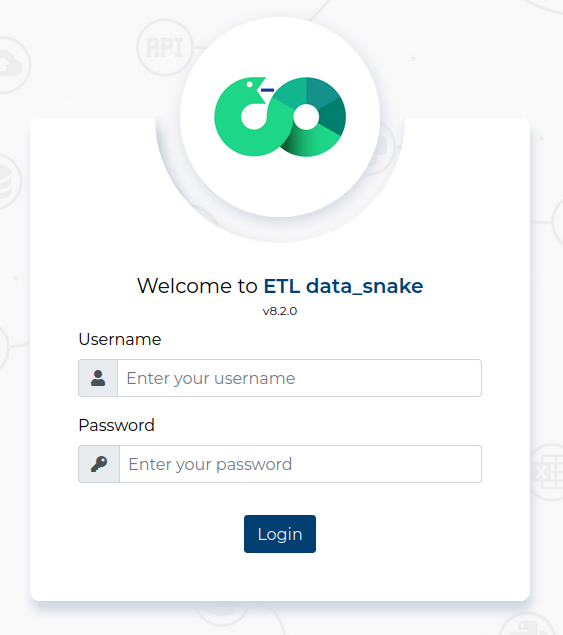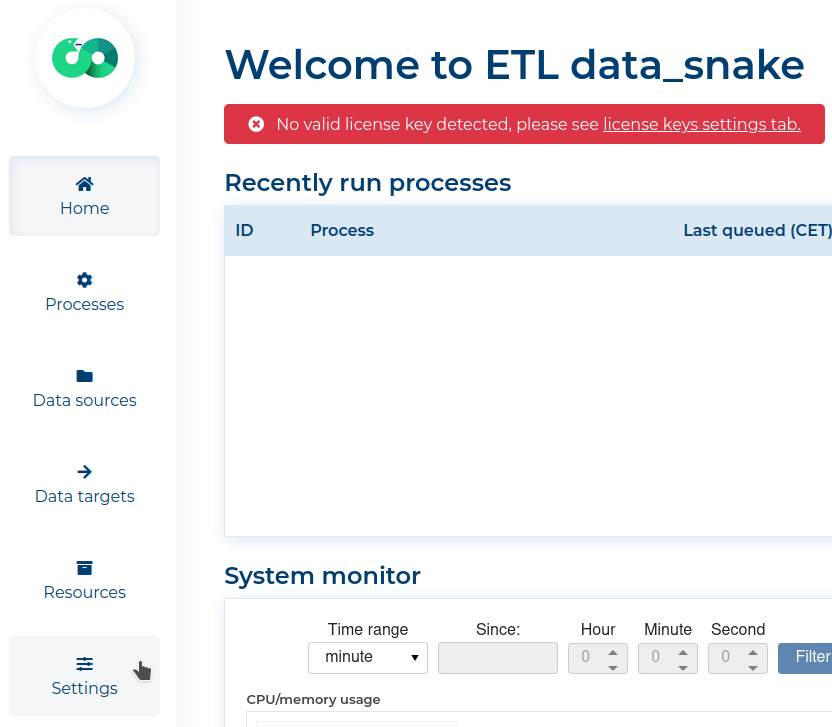How to Install #
To install ETL data_snake, follow these steps:
-
Visit the The Official data_snake Docker Page.
-
Create a folder where you will have the
docker-compose.ymlfile.
mkdir data_snake
- Navigate to the folder.
cd data_snake
-
Create a file called
docker-compose.ymlusing your favourite text editor. -
Copy the following example into the
docker-compose.ymlfile
version: "3.5"
services:
redis:
image: redis:6.0.5-alpine
volumes:
- data_snake_redis:/data
postgres:
image: postgres:12-alpine
restart: always
environment: &pgenv
POSTGRES_DB: "data_snake"
POSTGRES_USER: "data_snake"
POSTGRES_PASSWORD: "data_snake"
volumes:
- data_snake_postgresql:/var/lib/postgresql/data
# Web application for ETL data_snake using gunicorn
etl-app: &etl-app
image: mgaltd/data_snake:latest
restart: always
depends_on:
- postgres
- redis
volumes:
- data_snake_media:/opt/etl/media
- data_snake_static:/opt/etl/static
- data_snake_logs:/opt/etl/logs
- data_snake_files:/opt/etl/files
- data_snake_cache:/opt/etl/cache
hostname: example.domain.com
environment: &djenv
<<: *pgenv
POSTGRES_HOST: "postgres"
POSTGRES_PORT: 5432
REDIS_HOST: "redis"
REDIS_PORT: 6379
REDIS_DB: 0
ETL_SECRET_KEY: "__this__must__be__change__on__production__server__"
ETL_DEBUG: "False" # !!! This must be string
# This is the address used for sharing and process api token;
# when using proxy this is the public address (e.g. mga.com.pl)
ETL_EXTERNAL_URL: "example.domain.com"
command: gunicorn
# Service etl application only for websockets connections (ASGI)
etl-app-asgi:
<<: *etl-app
environment:
<<: *djenv
# Websockets connections have low memory requirements. Do not limit them
ETL_MEMORY_AVAILABLE_LIMIT: '0'
command: uvicorn
# Service runs celery
service-celery: &celery
<<: *etl-app
command: celery
# Service runs processes celery
service-processes-celery:
<<: *celery
command: processes_celery
# Service runs system monitor celery
service-system-monitor-celery:
<<: *celery
command: system_monitor_celery
# Service runs beat celery
service-beat-celery:
<<: *celery
command: beat_celery
# That service starts only once, do collectstatic, migrate and dies
etl-set-state:
<<: *etl-app
restart: "no"
depends_on:
- etl-app
command: set_state
etl-nginx:
image: mgaltd/data_snake_webserver:latest
depends_on:
- etl-app
- etl-set-state
volumes:
- data_snake_media/:/opt/etl/media
- data_snake_static/:/opt/etl/static
# - data_snake_ssl/certificate.pem:/opdata_snake/ssl/certificate.pem
# - data_snake_ssl/key.pem:/opt/etl/ssl/key.pem
ports:
- 80:80
- 443:443
volumes:
data_snake_media:
data_snake_static:
data_snake_logs:
data_snake_files:
data_snake_cache:
data_snake_ssl:
data_snake_postgresql:
data_snake_redis:
-
Save the file.
-
Run the following command to start ETL data_snake. If you do not want to see the application output, add
-dat the end of the command.
docker-compose up
- If there are no errors then ETL data_snake is running. Visit https://127.0.0.1 to start working.
The first launch of the application may take up to several minutes.
To function properly, the application requires uploading a license key
- When you open ETL data_snake, you will be greeted by the login screen. Simply log in using the default credentials:
- Username:
admin- Password:
admin

- To work with the application, you need a valid License Key. On the Home Page click the Settings button.

- In the License keys tab, click the + Add a license key button.

- Enter your acquired License Key

When ETL data_snake finishes the installation process, go to the After Install section for further details about basic configuration.